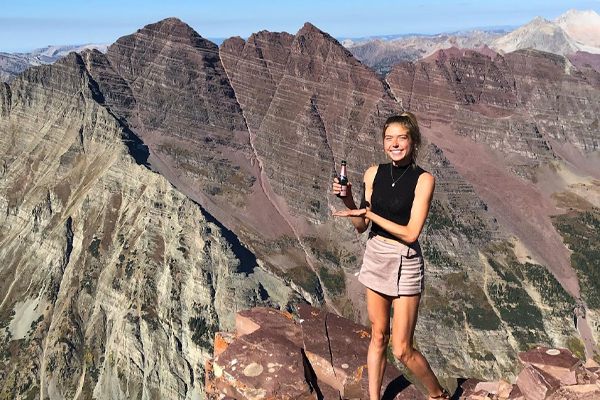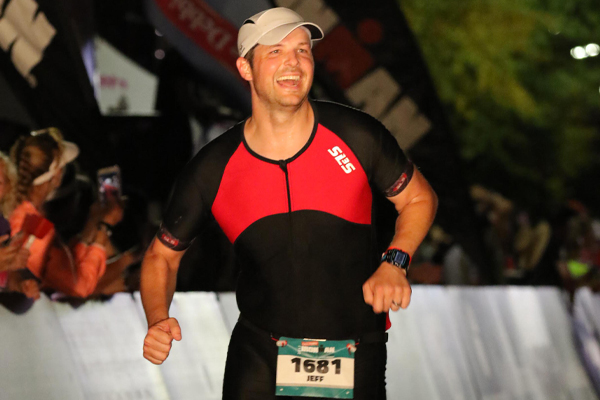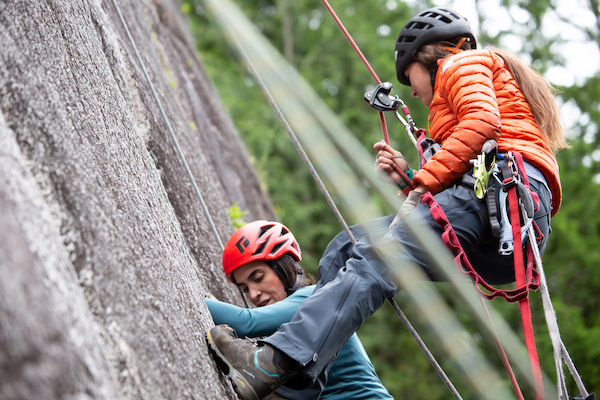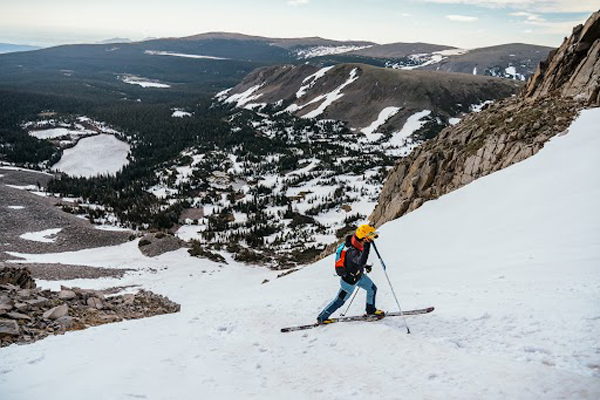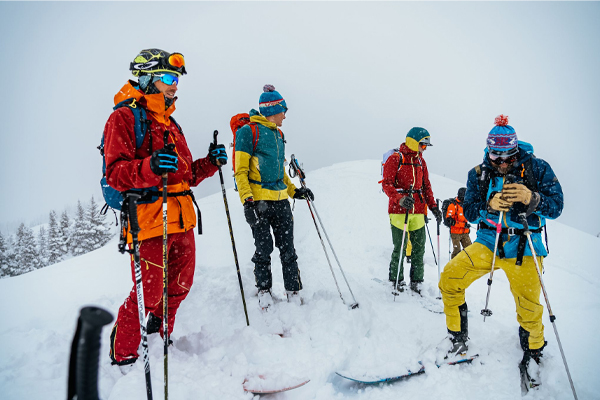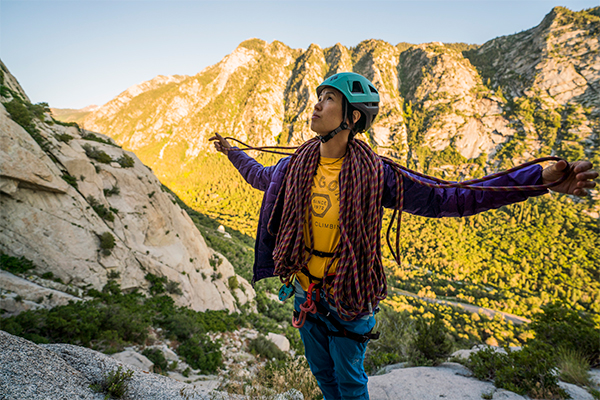Leadville 100 Through Two Sets of Eyes

For the 2023 Leadville Trail 100 presented by La Sportiva, we asked our partners at Boundless Coaching to survey their prospective runners for people with an inspiring story behind why they wanted to run 100 miles. We posted about our selected runner here. Having finished the race (congrats!), we asked Jeff to give us a recap of his race experience.
Jeff was the perfect runner for this, since he had a great reason for wanting to run, and had never run 100 miles. He would even tell you that he was not in running shape when he started training, which makes his finish all the more impressive. We thought it would be fun to compare and contrast Jeff’s experience to the other end of the spectrum, so we spliced Jeff’s race experience with Anton Krupicka’s recap from his 3rd place finish in 2021.
It is interesting to see that whether your goal is finishing on the podium or just hoping to finish, this race is full of highs and lows and is more than just a sport - it’s a life-changing experience.
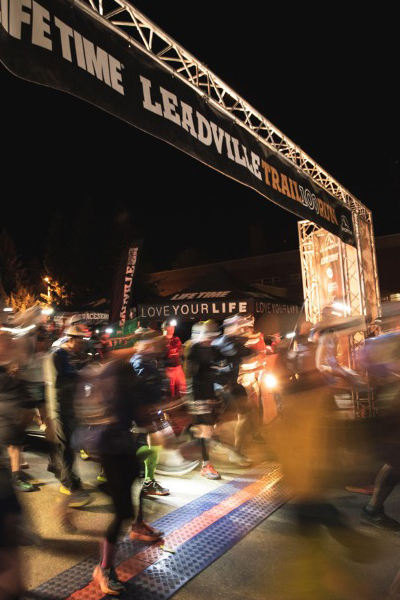
Start to Pipeline (0-27mi)
Jeff - 2023
After a night of too little sleep, we got up and got ready and at 4 AM the race kicked off. I was immediately reminded of the difficulty of running at altitude as I got underway and found it was hard to maintain the pace I wanted without my heart rate spiking. I settled back and took it easy for the first 12 miles or so, arriving at the first aid station about 30 minutes behind schedule. I quickly refilled my water and headed back out on course. About a half mile down the trail, I fell, and rolled off the side of the trail, twisting my ankle, breaking my watch band and almost ending my race early. I recovered though and carried on to mile 25 when I was able to meet my team. They were absolutely amazing and would have given a F1 pit crew a run for their money. They refilled and replenished my supplies, checked hot spots on my feet and got me back up and out of the aid station. The furthest I’d ever run before that was 26 miles so anything after this point was going to be uncharted territory. My legs weren’t feeling great, but I knew much worse was to come so I pushed down any feelings of discomfort and carried on.
Anton - 2021
Before race day, I had stated with conviction that my plan was to run my slowest first 50 miles ever. I wanted to preserve simply finishing above all other goals. No competing allowed until after mile 65; before that, jog and hike as easy as you can. I had run the first half of this race a full 15min under course record pace before. That didn’t end well; I DNFed at 80 miles. My fastest finish–16:14 in 2007, a time that still makes me the third fastest runner ever on the course–came off of my slowest split for the first 40 miles. There’s a painfully obvious lesson here. I was determined to have learned it.
I knew exactly one person on the start line – four-time champion Ian Sharman, who at 40 years old belongs to the same generation of ultrarunning as me–and that was it. The day before the race I met Cody Reed, who had publicly stated he was explicitly shooting for Matt Carpenter’s legendary 2005 course record. I knew that headspace. I’d occupied it intimately for a couple of years. I DNFed both times. But maybe Cody was more prepared, talented, and tougher than I was. Either way, I figured I’d be racing Ian for the win. Hard to argue with his experience and near-perfect track record at the event.
The run down to Turquoise Lake and over to Mayqueen was idyllic. A nearly full moon set behind Mt Massive and early on I even saw a spectacular, bright red shooting star streak over Massive’s northern skyline. A pack of 20-30 runners had already disappeared into the distance and I was proud of how I truly didn’t care. It’s always more fun to pass than be passed, so I figured each runner that was ahead of me at Mayqueen was just another little emotional boost I could count on later. My intermediate splits indicated that I was still easily on 17hr, or even 16hr pace. I knew 20 runners weren’t going to run 17hr today. Seeing the late-race carnage was going to be fun–so long as I wasn’t one of the fatalities.
Despite the race organization advising against crews meeting their runners at Mayqueen (limited parking), the scene there was raucous. I had forgotten what racing is like. There’s so much energy! Hailey and Len picked me out and without breaking stride, I acquired an extra bottle and a bean and cheese burrito to breakfast on. Eating real food was a new tactic for me this year and it would prove to be worth it.
Onto the CT and over Sugarloaf Pass I started picking off runners for whom it seemed the realities of the day’s work was setting in and early jitters were wearing off. Lotsa miles to go still, time to buckle down. A few folks were still chatty, but I wasn’t really. I just wanted to conserve energy and not get sucked into running too fast, especially on the steep Power-lines downhill.
Additionally, unlike every other time I’ve run this race, I walked nearly every steeper bit of uphill. Even when we hit the pavement over to Outward Bound I hiked a steep punch so that I could finish my burrito, plus running just seemed like too much effort. Man, what a difference 15 years make. In my first two years at Leadville, not walking a step was a point of brash pride. Now I saw hiking as almost a savings account. Every pitch I hiked in the first half was energy I was banking to draw on in those last 40 miles. It seemed to be working; I was consistently moving through the field and beginning to flirt with the top-10. However, all the flat running over to Pipeline–especially the paved road–was the usual bummer. Even though my legs felt clunky and without pep, I was mentally prepared for it and also boosted by the fact that I was still catching runners a marathon into the race.
Pipeline to Twin Lakes (27-38mi)
Jeff - 2023
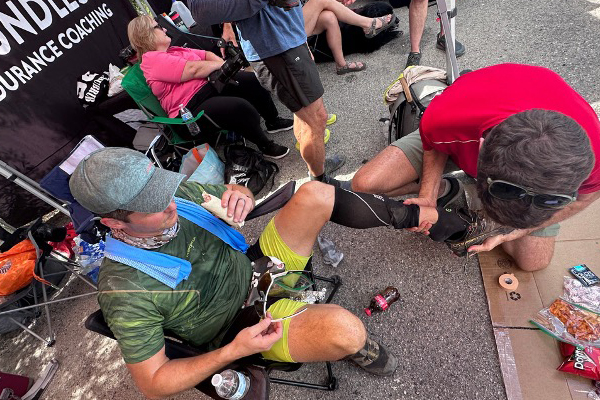
It was a mix of running the flat portions and hiking up hills and I pushed on until mile 38 when I came to the next full aid station (Twin Lakes) and met my team again. My feet were starting to show signs of blisters and irritation, so we changed my socks and bandaged them up as best as possible. The upcoming section was the "make or break" section of the trail. From mile 38 out to 50 you hike over the major climb, which is several thousand feet of climbing, before turning back around and hiking back into the same aid station at Twin Lakes. My coach and I had planned on a nine-hour transit of Hope Pass but as I headed out to hike over the mountain and then back again, I saw that I only had eight hours and 50 minutes before the 10 PM cut off. I didn’t have time to conserve energy for later in the race or keep my heart rate low. Either I would be back by 10 PM or my race was over.
Anton - 2021
At the crew access here I dropped my long-sleeve shirt, was finally back on dirt, and immediately felt better. Within minutes I could tell that I’d just been having a mild low patch on the pavement and now I was reaping the benefits of easing off and riding it out. On the gradual climb up to the Colorado Trail, I started picking off more racers who had clearly gone out too hot and were now paying for it after the initial quick, mostly flat 50K.
Shortly after, the course connects back into the CT, and up ahead I recognized the energetic, straight-armed hiking cadence of one Ian Sharman. No way! Already? I figured Ian was further up there duking it out with the young guns. I seemed to be riding a good wave at the moment, though, so I passed with some sort of hearty salutation about how I couldn’t believe we’re both still out here running at Leadville after all these years and how I had no doubt we’d be seeing more of each other throughout the day.
Sure enough, just a few miles later on the steep drop into Twin Lakes, Ian came flying by and I trailed him into the checkpoint by a few dozen seconds. While passing, he mentioned how no one ahead of us had finished Leadville before. Interesting bit of information; it reminded me that this was indeed a race and that Ian’s head was fully in competition mode, even if he wasn’t allowing his legs to go there yet. I’d been having more of a mental stroll down memory lane up to this point; Ian’s comment gave me a little shot of that competitive juice that makes racing so fun. Even so, I consciously tamped it down and worked through a quick transition with my crew. Onboard a jacket and a load of food for the 24 miles double-crossing of 12,600’ Hope Pass, get out of there.
Twin Lakes to Winfield (38-50mi)
Jeff - 2023
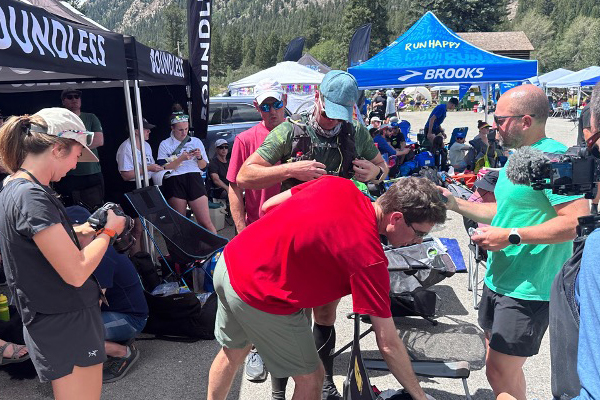
The next few hours were spent hiking up Hope Pass. It was an absolutely grueling section of the trail and I had to stop several times to catch my breath as I was pushing into the red. My heart rate was maxed out and I had more than a few doubts creep into my mind. I pushed those down and made up my mind that they could pull me off the course but I wasn't going to take myself out. By the time I got to the Hopeless Aid Station, just a half mile from the top, I was no more confident that I could complete this section in the required time than I was when I started hiking up the mountain so I simply moved through, only stopping for a quick refill of liquids.
Glancing around, I began to be acutely aware of the heat during this 8-hour stretch. The high for the race is usually around 64 degrees but the top of Hope Pass is often much cooler with snow on the ground. However, despite the forecast calling for similar conditions that day, the temperature didn't stop rising, topping out at a blistering 79 degrees. Each aid station had dozens of athletes laying on the ground, each turn in the trail had another athlete sitting on the ground, and a few had athletes in serious condition, struggling with the heat. Not only that but every athlete had white salt caked all over their clothes. Thankfully I was prepared. Not only was this similar to the conditions I'd trained in with the Atlanta heat, but I'd practiced taking significant amounts of salt pills to keep cramping at bay.
I didn't have time to rest however as I continued facing the cutoffs and headed down the trail as fast as I could towards Winfield, the 50-mile turnaround. I arrived with a little bit of time to spare, but quickly filled up and turned back around for the hike back.
Anton - 2021
I trailed Ian closely across the river and through the meadow to the base of the 3500’ climb up Hope Pass, fully expecting to re-pass him with ease. I think of the Hope double-crossing as being my type of terrain–steep hiking, thin air–and have always gained time through here in races past. Not so today. Within a few minutes, I could tell that not only was I not gaining on Ian, but that he might even be gapping me ever-so-slightly. Soon, my mind went negative and I hit the darkest mental thicket of the entire race. My legs hurt. I seemed to be getting dropped. My achilles was starting to burn.
Every single time I’ve raced 100 miles, I’ve thought about quitting at least once. This was that moment for me. I very briefly entertained the thought of the complicated logistics of dropping at Winfield–surely my achilles would prove to be a worthy excuse by that point–but quickly pushed those notions out of my mind and instead re-committed to finishing. Ooof, a 60-mile walk back to Leadville sounded miserable. I lamented not picking up some trekking poles from my crew at Twin Lakes. Paradoxically, all of this negative thinking distracted me enough to ease slightly off the pace and chill out, relax into the effort, and remember to just do what I could at the moment. No projecting into the future. My achilles was fine. Sure, my legs hurt, but I’d already run more than 40 miles, what did I expect?
Of course, soon enough, things started turning around. Ian wasn’t disappearing completely up the hill, and he and I were actually catching another runner in front of us. Before I knew it, we were marching into the Hopeless Aid station, one of my favorite spots
in North American ultrarunning. The setting a few hundred feet below the pass is idyllic, with wildflowers, llamas grazing, and enthusiastic volunteers who have camped out. I passed Matt Flaherty just before the aid station and shortly after did the same to Bryan Kerl. By the summit, I’d nearly caught Ian and my mood had turned 180 degrees.
The backside of Hope is bruisingly steep in spots, and I took it easy, still trying to save my quads. Ian did disappear into the forest here, aided by an untimely pit stop on my part, and by the time I hit the contour trail up to Winfield, I could feel myself hitting another minor low patch. No matter. I walked even the slightest uphill grades, using them as excuses to drink and eat, and was heartened when I heard cheers down in Winfield at 7h50–the leaders weren’t that far ahead...geez, maybe this is still doable.
Less than a mile out of Winfield the leaders of Adrian Macdonald and Tyler Andrews came running back towards me and then just a minute or so from the turnaround, Ian was marching towards me vigorously. Wow, had he and I really moved up so far in the field? I spent about five seconds in the aid station, filling a single water bottle (I had noted three different streams I could dip from on the way back up Hope), and grabbed a couple of slices of watermelon. I’d reached halfway in 8:05–nearly 20min slower than ever before. I was proud of myself for sticking to the plan and was curious if I could now reap some benefits in the second half.
Winfield to Twin Lakes (50-62mi)
Jeff - 2023
Athletes were laying all over the ground and I knew if I stopped to think, I might end up next to them. Doing some quick math, I knew I needed to make the return trip faster than the way out and this was to be difficult, because the backside is steeper than the front. However, I set my pace and pushed hard, and although I had some cramping, reached the top of Hope Pass one more time at 7:40 PM. As I reached the top and paused to take a quick video, tears welled up and spilled out of my eyes, the first outward sign I'd allowed myself at the emotional and physical effort I had put forth just to make it there. It was at this point that I had my first thought that I might actually have a shot to finish. I pushed that to the back of my mind and headed down the hill. I had just over two hours to make it off the mountain and back into Twin Lakes and it was about to get very dark and cold. I arrived back at Twin Lakes 23 minutes before the cutoff at 9:37PM, I'd made the out and back in 8 hours and 27 minutes - I was still in the race!
Anton - 2021
I was surprised to see Cody Reed still in the Winfield aid, and he followed me out as I started jogging back towards Leadville. Heading up the forest road back to the trail, Cody stubbornly ran a few yards in front of me while I hiked and munched my watermelon.
Twice I had to shout at him to keep him on course as he missed the race flagging. Once we were turned onto the trail I passed and knew that his competitive day was done–I was actually concerned for whether he would make it back over the pass in that kind of mental fog.
Ian must’ve been in a bit of a low patch himself as I soon saw him hiking a flat section up ahead. I still thought of Ian as the most dangerous competition, but my legs were feeling good and I rationalized that as long as I wasn’t pushing too hard it was fine to pass. If you’re feeling good, it’s always easier to lurk behind a competitor–you can see them, they’re not going to surprise you in any way–than it is to pass and be in the position of being chased. However, you also don’t want to waste good time in a race. If the legs are feeling good, it makes sense to capitalize on that at the moment, but always with a mind to not overextend oneself unnecessarily. I felt great on the trail back to Hope Pass and was further boosted by crossing all the runners on their way to Winfield. Once I hit the steep stuff up the pass I geared way down, really just walking up the mountain as easy as I could. Ian was behind me, I didn’t want to start trying hard until after Twin Lakes, everything was going well.
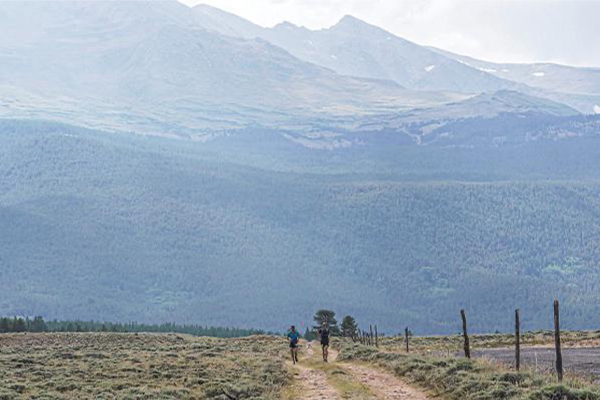
Above treeline, I caught a few glimpses of a shirtless Tyler Andrews marching up the switchbacks and figured that I must’ve cut into the ~15min gap that he held at halfway. It was here that I had a spontaneous feeling of gratitude for my situation. I was back racing the Leadville 100 after nearly a decade away, my legs felt great while running in the top-3, and it seemed like I was moving up even further in the field. I couldn’t believe it was all working out just as I’d hoped. There had been so many prolonged periods of doubt over the last seven years, it just felt so improbable that I would be back in the thick of things again at a major 100-mile mountain race. I felt lucky.
Once over the top, it didn’t take long for my running legs to come around and I spent the descent to Twin Lakes making sure that I wasn’t pounding too hard and that I was being as courteous as possible to all the runners still making their way up the pass the first time. I again reminded myself not to push until after Twin Lakes. And sure enough, a few minutes from the bottom of the hill, Ian came storming by, once again running the downhills faster than I was yet willing to. However, a few minutes later, we both passed Tyler, and just like that were running 2nd and 3rd overall, in a classic Colorado high country afternoon rainstorm, through the circus that is Twin Lakes at mile 62.
Twin Lakes to Pipeline (62-73mi)
Jeff - 2023
My team set about bandaging my feet and replacing my liquids and nutrition. I'd been running for 17 hours and 37 minutes but still had 40 miles to go and it was nighttime. Starting at this point, you are allowed to have a pacer. My buddy Justin was going to take the first shift from mile 62 to mile 77.
We took off up the hill out of Twin Lakes and pressed on through the night. The high of making it over Hope Pass wore off and fatigue set in at an all-new level. I was running on empty. At one point, I slowly shuffled to a halt, telling Justin that I simply couldn't keep moving. He stopped and came back to me, paused, and then LOUDLY clapped his hands directly under my bowed head, speaking firmly and loudly with each deafening clap..."GET! MOVING!" Yes, sir. At this point, I began to repeat to myself over and over a phrase that I would say to myself hundreds of times over the remainder of the event. "For my wife. For my children, Stone, Rosie, Ranger and Birdie. For myself. All for the glory of God." Over and over. Repeating it to myself. It was why I was here. It was why I couldn't just quit.
My feet began to shuffle forward again, and I ground out another mile or two, reaching the top of that section and, catching another wind, we moved quickly over the remaining 10 miles, reaching the Outward Bound station at 2:30AM. I collapsed into a chair and my team asked if I wanted to try and replace the bandages on my feet. I knew they were bad and simply shook my head. At this point, I knew whatever was going on under my socks wasn't good and it was just time to try and push the pain away and continue to hike on.
Anton - 2021
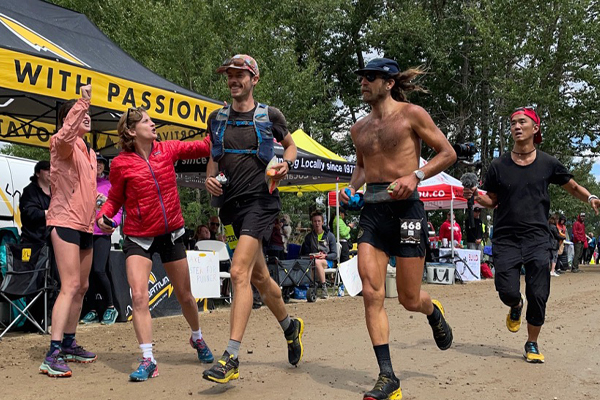
Before the race, I had waffled as to whether I wanted pacers or not. I lined up my buddy Len to help out Hailey with crewing but also to be on deck if I changed my mind about pacing. Len and I have been on a few bikepacking trips together, and from those, I knew him to have a lowkey, reliably pragmatic demeanor when things go sideways–desirable qualities in a pacer. Despite my pre-race thoughts, when I came through Twin Lakes at mile 40 that morning, hot on the heels of Ian, I had told Len to be ready when I returned. At Leadville, having someone to carry everything for you is an incalculable advantage.
Len had a running vest loaded up with any food or clothing I could ever want, all I had to do was hike. We followed Ian and his pacer Patrick up the hill at what I felt to be a pleasantly conservative pace. I was still wary of pushing too hard, but I was also still figuring that Ian was who I was really competing against, never mind the reports of Adrian being 15-20min off the front. Finally, right near the summit of the ~1500’ climb, Ian’s pace seemed to lag awkwardly, so Len and I jogged by and proceeded to run the next section of downhill and flat trail quite hard. When I noticed that Ian hadn’t followed, I calculated that this was finally the moment to open a gap and make it stick; I allowed the adrenaline of this realization to push me into some extended low-7min mile pace.
A couple of miles later I stopped to change my river-soaked socks and let my macerated feet dry out for a second; I was heartened when Ian didn’t catch up during that 2min pause. The rest of the way to Pipeline I kept on the gas as best I could. This section had been my undoing in nearly every other Leadville 100 I had ever run. I’d never been passed on this section because I always came off Hope Pass with a sizable lead, but my lagging pace here typically preceded either a pass or a big blow-up shortly thereafter. Additionally, this was often where my stomach rebelled and continuing to consume calories became an issue. This year, however, after emphasizing real food for the first 60 miles, my stomach was still reacting positively to the easy-to-eat gels I’d been consuming since passing Ian. It felt gratifying to (for once) be running well after mile 70 instead of just surviving.
Pipeline to Mayqueen (73-88mi)
Jeff - 2023
My friend Kevin took the next section from mile 77 to mile 88. It had the hardest section remaining. I had no idea whether it was even possible to keep moving at this point but simply got up, gave everyone a hug and we made our way out. Kevin did a great job, plotting a course up the rugged mountain pass, navigating both my grumpy directions and the baseball size rocks all over the course as we made our way up. Powerline was seemingly never-ending but by simply putting one foot in front of another, we reached the top of the hardest section, pausing to look back at the head lamps coming up the trail over the two miles behind us. That morning, the lights had stretched one after another, blending together over the miles. Now, there were very few, reinforcing the feeling I had when I looked at my watch. There weren't many people who were still in the race at my pace, they'd either quit or been pulled from the course. We turned and pushed on into the night. The last significant technical section came at mile 85, traversing a downhill, boulder filled section of the Colorado Trail. My biggest fear now was going off the side of the trail or breaking my ankle as I moved between a light delirium and forced focus. We pushed on, not hitting our intended pace but making good progress and moving through the dark woods.
As we came off the Colorado Trail, we were greeted a half mile from the aid station by my brother Andy who jogged in with us. I stopped briefly at the aid station, drank some broth and shook my head "no" when they asked if I wanted to sit down. I desperately needed the rest but what I knew in my heart but didn't say out loud to my crew was that if I sat down, I wouldn't be able to get back up. Despite taking the maximum allowable amounts of pain medication by this point, my pain was to the point that it seemed like I had taken none. Simply moving one foot in front of the other at a moderate walk brought my pain to a level unlike anything I'd previously experienced in any event I'd ever done. Both for my crew and for myself, I continued to push this to the back of my mind and smiled, looking around at the growing light, my crew and the few remaining runners coming by with gratitude. I was doubtful still that I could continue but at this point all I could think was that I was thankful for everything that had transpired up to that point, thankful for the opportunity and would give it whatever I had left.
Anton - 2021

I always dread the paved road in this section; there have been years (2009) where I’ve walked every step. There has never been a year where I’ve run it well. This year, despite it being the first time I’d ever embarked on it, not in the lead, I was finally happy with it. We had a tailwind out of the south, and cutting off the road onto the lumpy pasture portion leading to the Outward Bound aid station helped revive my legs. At the bottom of the Powerlines we ran by my buddies Jeff and Homie and I was relieved to be back on some steep hiking grades.
Marching up to the 11,100’ Sugarloaf Pass I tried to stay steady–we’d been able to confirm a 6min time gap on our nearest pursuer, who we assumed was still Ian (it was actually a resurgent Matt)–but not go too hard and blow up prematurely. Upon reaching the summit, the 82 miles had begun taking their toll, but I eventually got rolling and was able to run hard all the way down into Mayqueen at mile 88.
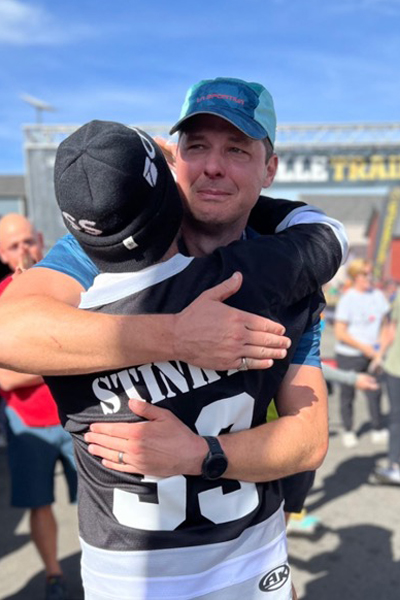
Mayqueen to the Finish (88-100mi)
Jeff - 2023
As my brother Andy and I left the aid station, we quickly calculated the time we needed to hit to be able to finish the race by the 10:00AM cut off. We had 12.2 miles to go and had left the aid station at 26 hours and 15 minutes, just 15 minutes ahead of the final aid station cut off. At this point, I was moving at a completely erratic pace, walking when I had to, jogging some sections when I had a burst of panic. Within a few miles however, despair crept in as I sensed that I couldn't keep moving at the pace needed to finish on time. "I can't keep moving at this pace for another 10 miles, I can't do it", I said to my brother.”You don't have to keep it up for 10 miles,” he said. “You just need to do it for right now. Can you keep it up right now?"
My eyes teared up as I did a quick self-evaluation of my physical and emotional state. I was so empty of everything I had to give. I had absolutely nothing left.
Except I did. Tucked back in a corner somewhere in my heart, there was something there. It wasn't much but it was enough for "right now."
Over the next several miles, I continued to search for, and find, the will to continue. Our pace became steadier, we made progress. Just as we began to feel like we'd done what was necessary, with just a few miles to go, Andy got the text that would put all that in doubt.
"You have to get him to move faster. You aren't going to make it." Andy told me about the text, and I immediately panicked. How was that possible? We'd done the math. Was I wrong in my calculations? This was certainly possible, as I had been up for over 30 hours and was delirious with pain and fatigue. I did the math again, had Andy recheck it, and recheck it again. Our math was right, we had enough time to complete the remaining 2.5 miles.
"He doesn't have 2.5 miles to go. He has 3.5 miles to go." The text came back with devastating effect.
Andy immediately said "We have to go. We have to go faster now." I almost stopped and crumpled to the ground. I knew that wasn't possible. How was this possible, I repeated aloud to no one in particular. I looked around at the other few runners around me, one about 30 yards ahead and one 30 yards behind. They looked self-assured and moving at the same pace as I was. Surely they and their pacers would be panicked if they were also going to arrive mere minutes after the cut off?
Andy sprinted ahead to check with the nearest runners as I tried to figure out what had gone wrong. I remembered that the first aid station Mayqueen used to be at a different point on the course in years past. I then remembered that on the "Aid Stations and Course Cutoffs" section of the Leadville website, that there was no mile marker listed for the Mayqueen Inbound aid station. I'd simply made a typo, likely confusing the old mile marker for the aid station. I had just worked this out in my mind when a local seated next to the trail yelled out "2.5 miles to go!"
"How many?", I replied.
"2.5!," he responded. I could have hugged him. Andy returned from the other runners and confirmed the same thing. We sent a reassuring text to my crew and trudged on.
The Leadville course comes back into town about a mile from the finish line and it was at this point that I first allowed myself to realize that I would finish. I began to think for the first time about the fact that I was about to finish one of the hardest endurance events in the country. With only 110 days of training. As I crested the hill overlooking the finish line, Jessica, Justin and Kevin met us and we slowed to a brisk walk. Emotions began flooding my heart and my head. I could scarcely process what was going on. The crowd lined the course and cheered wildly for each runner. Everyone suffers at Leadville, but we had the distinction of suffering the longest. I began to jog as I approached the finish line with my team. As I crossed the finish line, the emotions crested, and I wept as I realized what I had accomplished. The team and I embraced, and I thanked each of them, all of us emotional at what we had just gone through and done together. I hugged my coach with tears running down my face and thanked him for all the help.
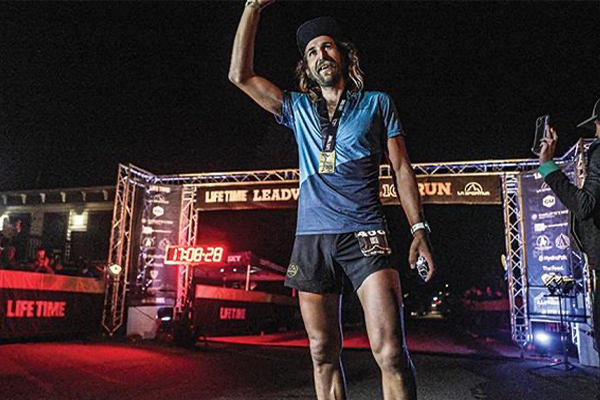
I'd finished the Leadville 100 Trail run in 29 hours and 47 minutes, a mere 13 minutes before the final shotgun fired and they closed the course. It was unbelievable.
Over the next few days, I struggled to process all that had happened. Due to the exertion at altitude, there was a significant amount of water in my lungs, and I had a bad cough for weeks. My feet were absolutely wrecked, and I had huge blisters and would lose several toenails. Sleeping sounded great but every few minutes I would be awakened at the pain from the slightest movement for the first few days.
But it was all worth it. Not only had I proved to myself that I was worthy of respect, but I had captured a moment for my family to show them that anything is possible. A week after I returned, Jessica was in the kitchen and our seven-year-old Stone randomly came up to her and said "I think Dad's right, mom. Anything is possible." What a blessing to be able to show that to my children.
Anton - 2021
From Mayqueen, you can put all of your focus into the finish line. It is finally an attainable goal. Leaving Mayqueen at 14:54, the reports were such that I really had no chance of catching Adrian, but I was quite optimistic for maintaining 2nd place in a substantially sub-17hr finish. Two hours for 13 mostly flat miles is totally reasonable.
Well, racing 100 miles is not reasonable. The next six miles over to the Tabor Boat Ramp (mile 94) were an interminable rollercoaster of hiking and meager jogging. For pacers, I’d switched from Len to an old college cross-country buddy, Dan Kraft. Dan had raced to 4th place in the Pikes Peak Ascent that morning and then driven up just to help me out at Leadville in the evening. I felt bad that after my strong running with Len I seemingly couldn’t muster a performance worthy of Dan’s considerable effort to be there.
Just as Dan was commenting on the beautiful sunset alpenglow on the Mosquito Range (it was) and I was starting to feel some minor relief at finally getting to the Boat Ramp, where the trail would smooth out for good, Matt Flaherty and his pacer came flying by. Ooofffff. After running in 2nd place for the last 30 miles, this felt like a rude puncturing of a gradually inflating balloon of momentum that I’d been counting on to carry me to the finish. For a few seconds I tried to lift my stride in an effort to minimize the gap that Matt would be able to create, but it was futile. My legs were concrete blocks.
Either way, the remaining hour of running to get to Leadville was a definite low-light of the day, but when I finally crested the last hill by the hospital on 6th Street, running up to the finish line was just as sweet as I remember from my previous three successful attempts at the event. What’s the takeaway? I’m not sure.
One thing is for sure–I’m not the same person that first ran that 17hr-flat time winning the Leadville 100 15 years ago. Although my result this year seemed eerily similar on paper, my relationship to running and racing has changed immensely over the last decade and a half. I love running, but I am just as fulfilled by other outdoor activities–climbing, cycling, skiing–and as a result I feel like a more balanced individual.
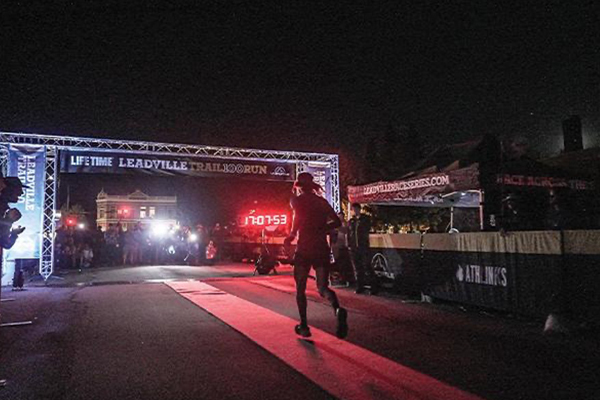
When I was focused on purely running, I carried a bit of a chip on my shoulder, entering races to prove myself and beat others. When I started winning ultras, it was the first time that all of the time and energy I was putting into running was validated. A lot of my motivation for racing was external. At Leadville this year, the motivation felt much more internal, hence, I think, the calm nerves and unconcerned attitude in the days leading up to the race. I was interested in testing myself against the distance and the course and seeing how my mind and body would respond to the challenge. I wasn’t there to explicitly beat anybody. Instead, I viewed my competitors as simply co-conspirators with the same goal–run 100 miles through the mountains as quickly and efficiently as we could. Their presence was necessary for helping me find my limits, not to serve as adversaries.

